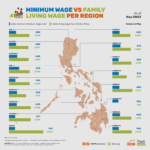In an interview in December 2023, Teresita Sy-Coson, vice-chairperson of SM Investment Corporation, bemoaned over what she said was the “antagonistic approach” of the Marcos Jr government towards China. She was referring to the series of open criticisms by the regime’s officials over skirmishes between Philippine military ships and the Chinese coast guard in the last months of 2023. On US prodding, the AFP intensified its “supply missions” for the shipwrecked BSP Sierra Madre in Ayungin Shoal. Chinese forces have arrogantly and aggressively confronted these.
These confrontations, accompanied by US flights of jet fighters and armed drones, have raised the possibility of an armed encounter at sea. Like China, the US maintains a constant, in fact, larger, military force not only in the South China Sea, but within the Philippines itself.
Sy was the first big bourgeois-comprador to openly express disapproval against the Marcos regime’s “aggressive interactions” with China. She clearly indicated the negative implications for local businesses and investments tied to Chinese capital. “China is very close to us, we cannot afford to be too antagonistic,” Sy said in a Bloomberg magazine article published on December 14. “We don’t want to get involved in US-China tensions,” she said.
The Sy family is among those who benefited greatly from the influx of Chinese surplus capital into the Philippines which the US encouraged since the 1990s. Under the banner of “globalization” and “free trade,” US and China conspired to open the markets of the Philippines and other underdeveloped countries to dump their surplus capital and products. This, however, did not prevent the outbreak of inherent competition in the form of a trade war between the US and the emerging Chinese imperialist power.
According to the CPP Central Committee in its December 26 statement, “the US drive to undermine China is a reversal of the long period of collusion between the two imperialist powers to impose a neoliberal policy regime in the Philippines since the 1990s”
Since 2000, the annual value of Philippine imports from China grew by 42%. In 2016, China surpassed Japan as the nation’s largest trade source. Today, it is the Philippines’ largest source of imported materials and products, and the second largest export market. One of these products is refined oil products, which is key to the local economy’s operation.
Nevertheless, China has been able to dump less capital in the form of foreign direct investment compared to the US. (See table). But it has gradually grown and in 2022, China’s FDI in the Philippines reached $1.11 billion. Some studies also estimate that China’s FDI has reached $2.5 trillion from 1990 to 2015.
Bourgeois and bureaucrat Chinese camp
The CC also said, “the Chinese financial oligarchy used this period to expand commercial and financial operations in the Philippines, alongside that of US and Japanese banks, and build its own base among the bourgeois compradors and bureaucrat capitalists.”
China aggressively expanded its influence in the country during the Arroyo regime. From 2001-2010, it signed 15 bilateral agreements and 20 major projects. Many of these contracts were discontinued over exposure of gross corruption and anomalies of those involved. During this period, the partnership between China and Enrique Razon was formed to control the National Grid Corporation of the Philippines. Razon later sold his shares to the Sy and Cojuito families, the current Chinese partners.
The tie-ups of the biggest Filipino bourgeoisie and Chinese companies continued under Benigno Aquino III. Like how the US partners with various business chambers, China channeled its investment into the Federation of Filipino-Chinese Chambers of Commerce & Industry, Inc. China also granted capital and contracts to so-called Filipino “taipans,” to expand businesses in Beijing, Shanghai and other major cities.
The partnerships between the Filipino bourgeoisie and bureaucrats and China was most apparent during the Rodrigo Duterte era. His cronies, including Davao-based businessmen, entered into all sorts of contracts. The most prominent crony is Dennis Uy, who partnered with China in an attempt to build a telecommunications infrastructure and devoured many companies in a short period of time. Razon, the Gatchalians and many others clearly benefited from the contracts.
Even during the US-Marcos Jr regime, the local bourgeoisie continued to seek Chinese capital. In January 2023, Ferdinand Marcos Jr visited China, where he signed 15 bilateral agreements between his and the Chinese governments. In February 2023, the Senate ratified the country’s entry into the Regional Comprehensive Economic Partnership (RCEP), a Chinese initiative. RCEP is a Chinese instrument for the unimpeded dumping of its surplus products on Asian markets at the expense of local businesses and producers.
But conditions seem to have changed in recent months when the Marcos government canceled its loans and contracts for large infrastructure projects such as dams, railway systems, and others funded by China. Among those canceled are the Philippine National Railways South Long Haul, Subic-Clark Railway and Mindanao Railway projects.
The regime is now in the process of transferring funding contracts to the ADB, the World Bank (the original proponent of some of the projects) and other US allies. The US also urged the cancellation of reclamation projects in Manila Bay near its embassy on Roxas Boulevard.
These measures have brought about new conflicts among the bourgeoisie and bureaucrats competing for lucrative contracts.



